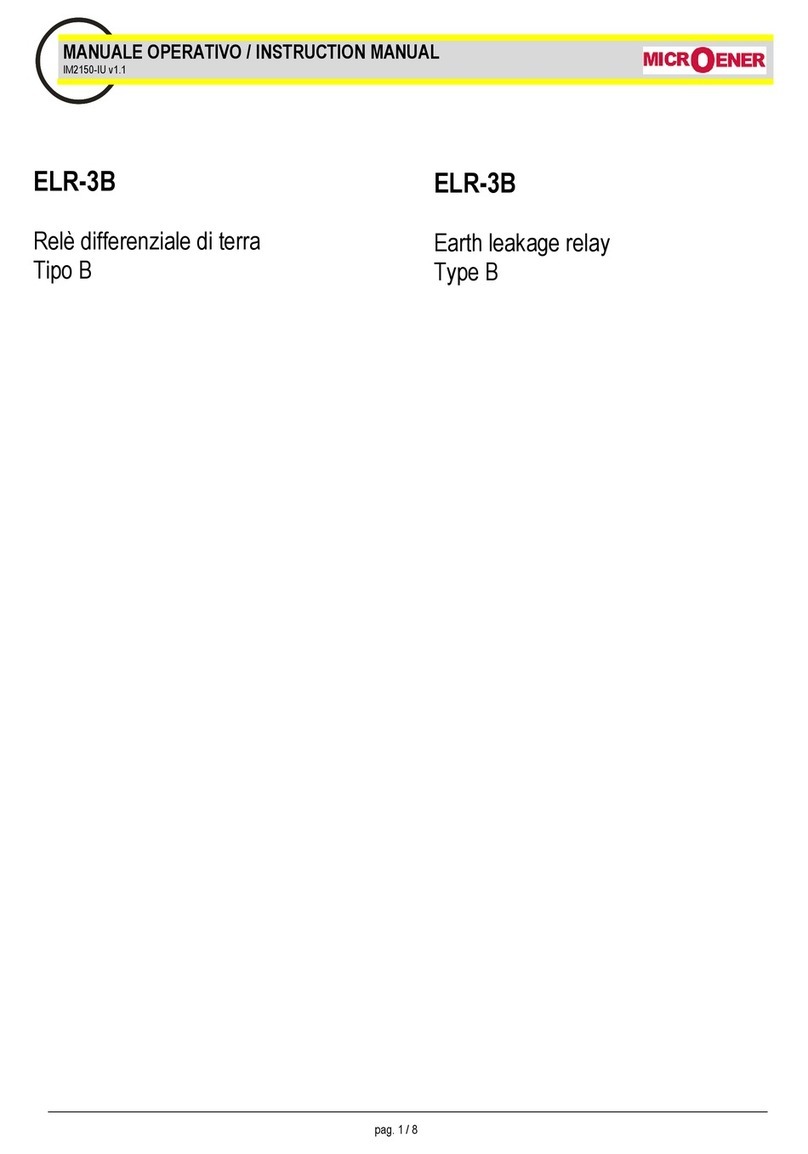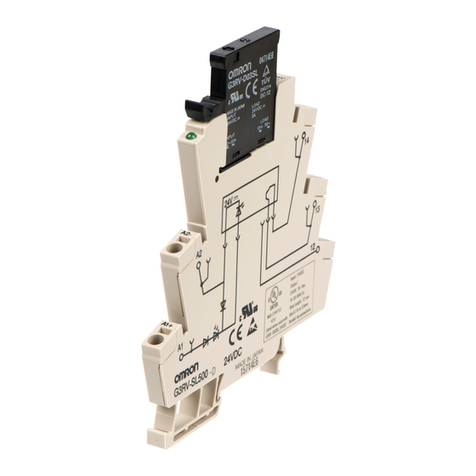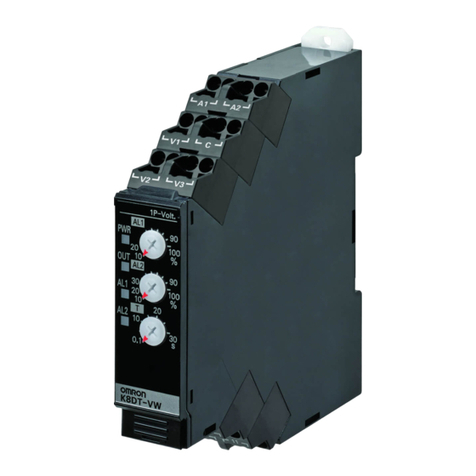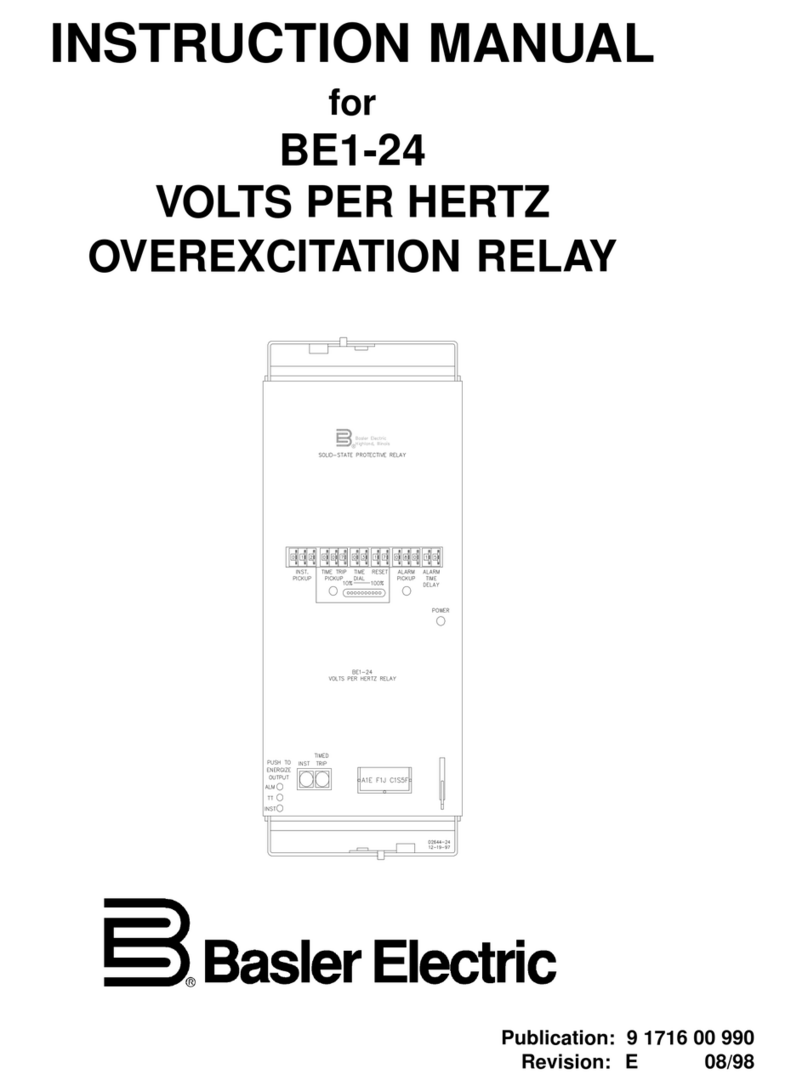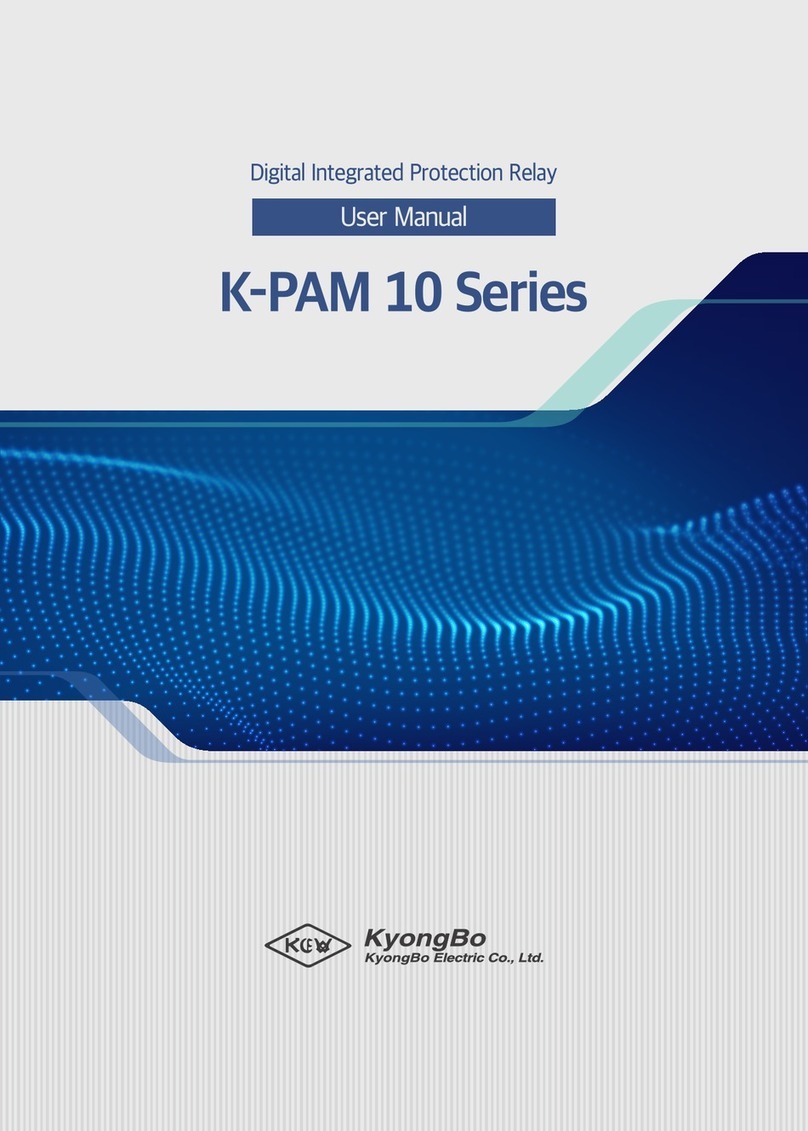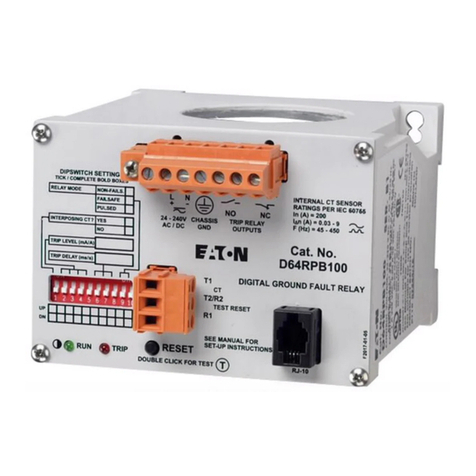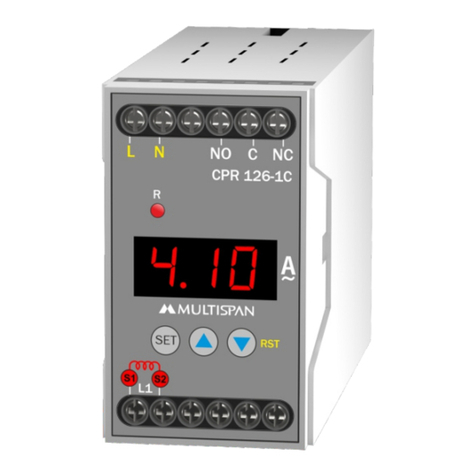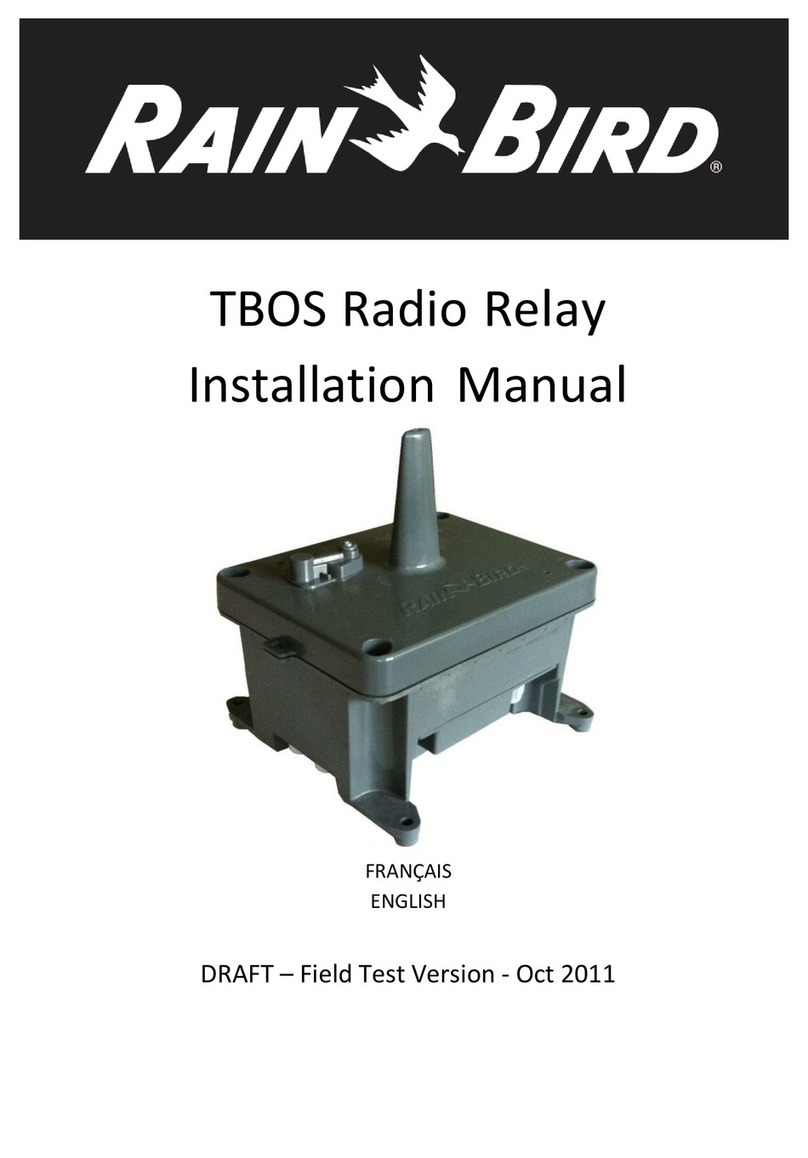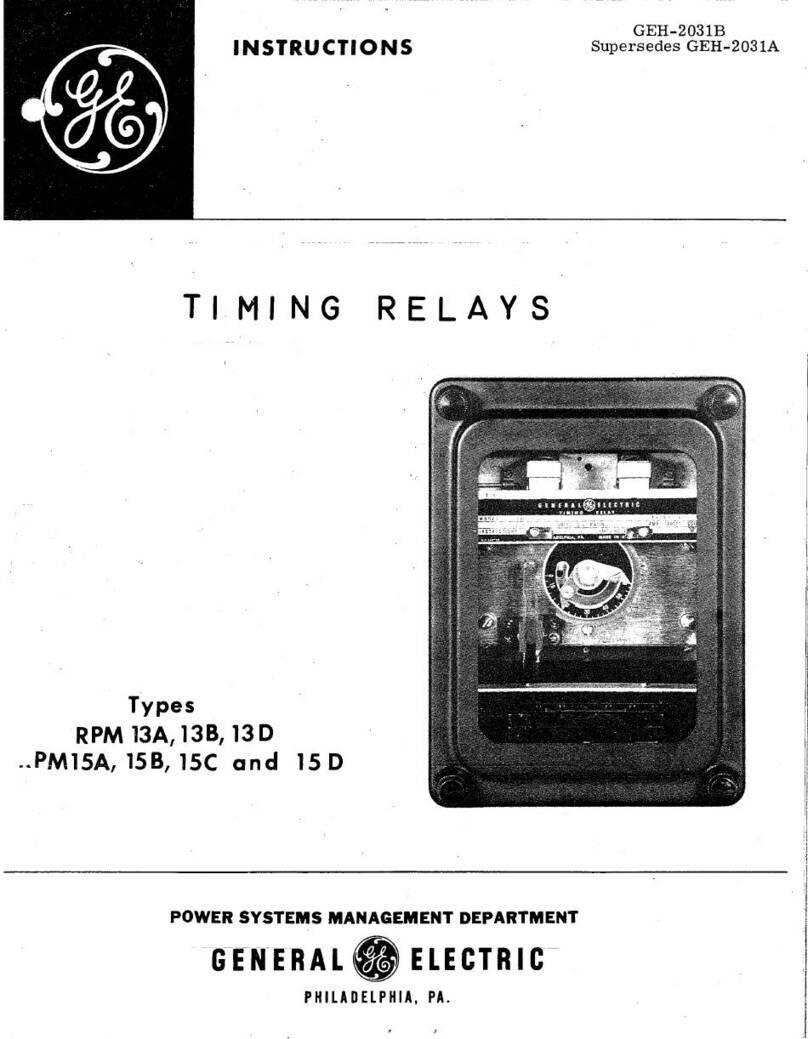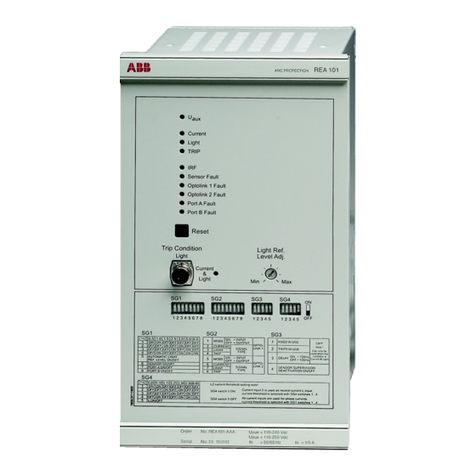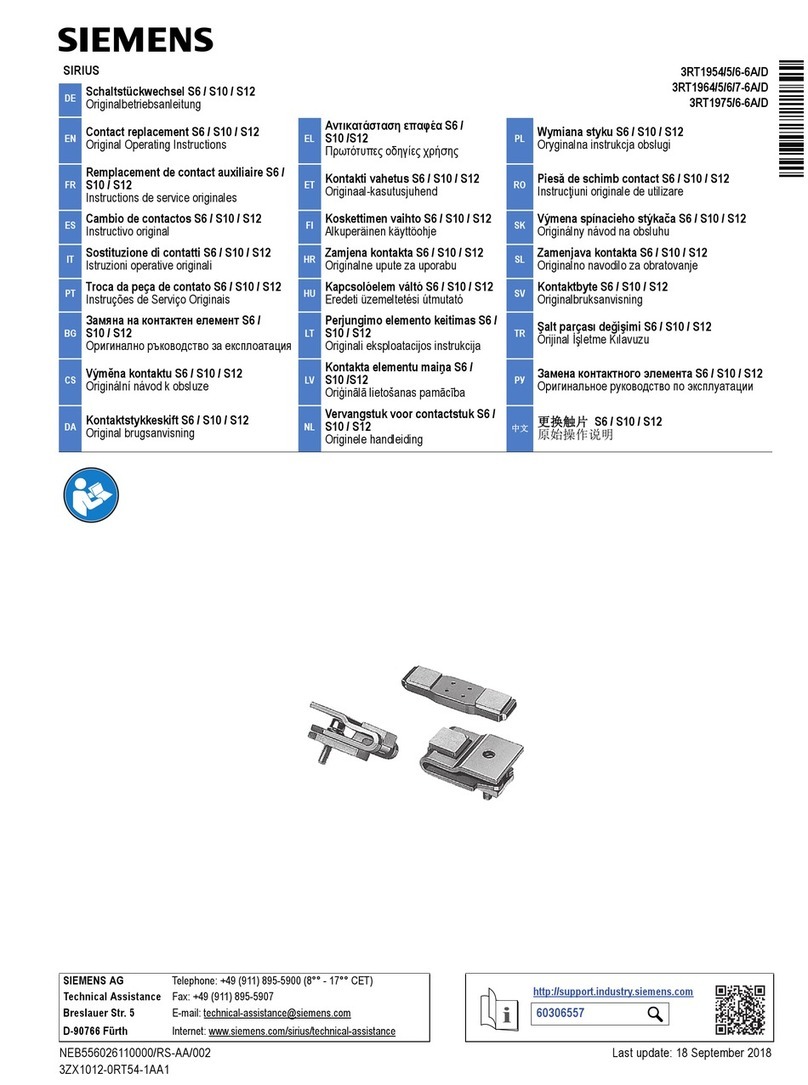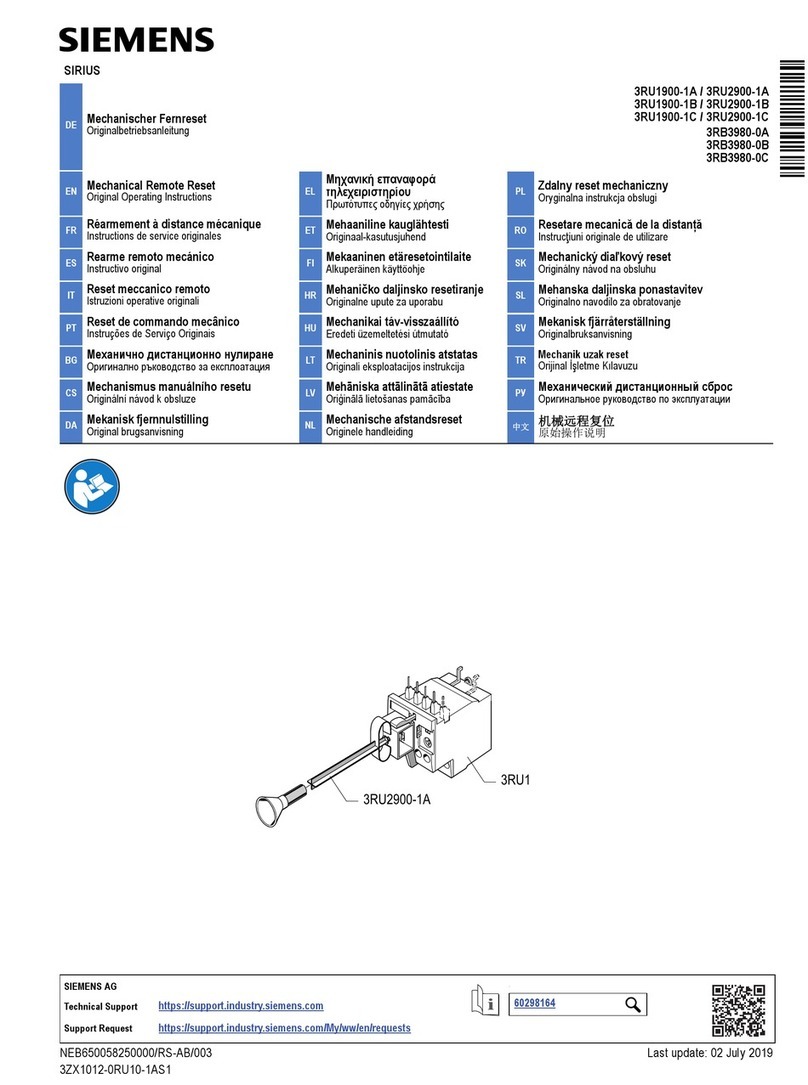New Elec KB LV User manual

Overload (for both cyclic and sustained overload conditions)
Single phasing / unbalance
Undercurrent / load loss
Overload protection is provided against cyclic and sustained overloads. Pre-loading with thermal memory,
utilising accurate hot and cold thermal curve characteristics to IEC 255-8 provides this protection. The thermal
IDMT curve is Class 15 cold and Class 5 hot. This curve will provide adequate protection in the event of a motor
stall, both during starting and running conditions.
Should the motor load exceed the thermal capacity allowed by the thermal IDMT curve (Class 15 cold and Class
5 hot curve) the motor overload LED indicator will be illuminated, the relay healthy indicator switched off and
the main trip relay de-energised to stop the motor.
The same motor overload LED can be used to read the actual load current being drawn by the motor during
normal running conditions. This is achieved by pressing and holding the control panel mounted reset
pushbutton, while trimming back the maximum load current dial, until the motor overload LED switches on.
The calibration on the max load current dial at which this occurs is the actual load current being drawn by the
motor.
In the event of a motor overload trip the entire thermal capacity of the motor has been utilised. If auto reset has
been selected the motor overload LED will flash at a one-second rate until the thermal capacity has integrated
to 33%. At this point the overload LED will switch off and the relay healthy LED will switch on to indicate that
the motor can be returned to service. The relay will reset to a Class 5 hot curve.
298 Soutter Street, Pretoria West
Postnet Suite #73, Private Bag X06, Quagga, 0058
Tel: (012) 327-1729 Fax: (012) 327-1733
KB LV Motor Protection Relay
INSTALLATION AND SETTING UP PROCEDURE
Example 1:
Protection for 3 kW 380 Volt three-phase motor
Motor full load 6,5 Amp
Suggestion:
KB10 / 380V
Example 2:
Protection for 132 kW 525 Volt four-pole, three-phase motor
Motor Full Load 175 Amp
KB200/525/200:5
Ordering examples for the various models
Interposing secondary
Model or relay type Current setting range current transformer
ratio where required
KB 1 0,1 to 1 Amp Not required
KB 5 0,5 to 5 Amp Not required
KB 10 1 to 10 Amp Not required
KB 25 2,5 to 25 Amp Not required
KB 50 5 to 50 Amp 50:5 Class 1 2,5 VA
KB 100 10 to 100 Amp 100:5 Class 1 2,5 VA
KB 200 25 to 200 Amp 200:5 Class 1 2,5 VA
1. Protection Features
2. Description of Operation
10. Ordering Information

If manual reset is selected, the motor overload LED will remain on until the control panel mounted reset button
is pressed. If the reset pushbutton is pressed and the thermal capacity has not integrated to 33% the auto-
reset sequence is initiated. If the thermal capacity has integrated to >33% then the overload LED will switch
off, the relay healthy LED will switch on and the main trip relay will be re-energised and the motor returned
to service.
Phase unbalance protection is provided independent of motor load. In the event of the three line currents
becoming unbalanced by more than 30% a 5 second trip delay is initiated. After tripping, the phase unbalance
LED will be illuminated, the relay healthy indicator switched off, and the main trip relay de-energised to stop
the motor.
Should the motor load current, during normal operation, drop below the minimum load % MLC dial setting,
while still being >10% of the maximum load current dial value for the full 10 second period, the minimum
load LED will be illuminated, the relay healthy indicator switched off, and the main trip relay de-energised to
stop the motor.
If, during the 10 second trip time period, the motor load current increases above minimum load % MLC dial
setting, and then once more drops below the minimum load % MLC dial setting value, a new 10 second trip
delay period is initiated. The minimum load value can be adjusted during normal running conditions by
pressing and holding the control panel-mounted reset pushbutton, while trimming forward (clockwise) the
minimum load % MLC dial, until the “Min Load Trip”LED turns on. The calibration on the minimum load % MLC
dial where this occurs is the actual % load of the maximum load dial setting being drawn by the motor.
If the control panel-mounted auto/manual selector switch is in the auto position it will have no bearing on
the minimum load reset as this will only be reset manually. SHOULD YOUR APPLICATION REQUIRE AN AUTO-
RESET ON THE MINIMUM LOAD FUNCTION THIS MUST BE SPECIFIED AT THE TIME OF ORDER. The following
red LED trip indicators with clear descritive fault conditions have been mounted on the control panel to assist
maintenance personnel in determining the exact cause of the trip.
* Motor Overload
* Phase Unbalance
* Minimum Load
A green LED is included to indicate the relay healthy status.
KB LV MOTOR PROTECTION RELAY KB LV MOTOR PROTECTION RELAY
8. Dimensional Diagram
9. Electrical Connection Diagram

KB LV MOTOR PROTECTION RELAY KB LV MOTOR PROTECTION RELAY
INPUT CONVERTER
Class : Class 1
Rating : 0,1 VA
Frequency response : 40 – 66 Hz
OVERLOAD TRIP DELAY CURVES
Cold
T TRIP = 15 (35,49) Ln (I/Ie)2- (Ip/Ie)2
((I/Ie )2 - 1)
Hot
T TRIP = 5 (35,49) Ln (I/Ie)2 - (Ip/Ie)2
((I/Ie)2- 1)
Accuracy: ± 5% 1,2 X Ie to 6 X Ie
± 10% 1.01 X Ie to 1,2 X Ie
UNBALANCE / SINGLE PHASING SETTING
Level setting : > 30% Ie
(motor full load)
Trip delay : 5s
FAULT INDICATION
Operation : Latch on trip
Resetting fault indication : Latch
ENVIRONMENTAL SPECIFICATIONS
Reference standards IEC 255
Isolation N/O contact
1 kV for 1 minute To IEC 255-5 C
Isolation separate contacts
1 kV for 1 minute To IEC 255-5 C
Impulse withstand
5 kV To IEC 255-4 EIII
High frequency
IEC 255-4 C III
MAXIMUM LOAD CURRENT SETTING
Level setting accuracy : ± 2%
Linearity : ± 2%
Repeatability : ± 1%
Detection level : ± 2%
Calibration : Amps
OVERLOAD THERMAL LOCK-OUT TIME TO RECOVER
33% CAPACITY
T reset = Curve [2.33 (35,49 x 2) 15 log
(100/70)] – Motor running
T reset = Curve [2.33 (35,49 x 4) 15 log
(100/70)] – Motor standstill
MAIN TRIP RELAY
Current rating : 5 Amps 220
Volt a.c
Configuration : 1n/o + 1n/c
Terminals n/c 7 and 8
: n/o 9 and 10
UNDERLOAD DETECTION
Range : 10 to 100% of maximum
load setting dial
Trip delay : 10 seconds
7. Specifications
This user-friendly relay requires only that you set the motor full load current on the “Max Load Current Amp” dial
to coincide with the protected motor’s full load capability. Prior knowledge of the no load current value of the
protected motor, if known, will be useful. However, it is not necessary, as a procedure will be outlined below to
determine this value.
Note: This relay has a fixed cold thermal curve of 15 seconds which integrates to a 5 second curve as the motor reaches it’s full
thermal capacity. Use of this product on large motors designed for cold thermal curves in excess of 15 seconds will result in over
protection of the motor.
3. Information required for Initial Settings

COLD CURVE
CLASS 15
COLD CURVE
CLASS 5
In a similar fashion, if the motor is run under no load, while consistently pressing the reset button on the control panel it is
possible to accurately determine the % drop in load. This is achieved by setting the“MIN LOAD % MLC AMPS”dial to the minimum
value and then rotating the setting knob slowly clockwise until the MIN LOAD LED lights up. Leave this as a final setting.
No additional features can be set OR disabled on site.
5. Adding or Removing Features on Site
6. Thermal Trip Curves
KB LV MOTOR PROTECTION RELAY KB LV MOTOR PROTECTION RELAY
Ensure that the selected KB relay does in fact cover the full load current range of the protected
motor. Note that the models KB 1; KB 5; KB 10 and KB 25 do not require any additional current
transformers. The relay MUST be installed in the MAIN CIRCUIT of the starter. Being compact in
design the built-in single-turn feed-through primary winding transformers permit the main circuit
cable conductors of up to 7 mm to pass through the protection relay. In the case of the models
KB 50; KB 100 and KB 200 interposing current transformers of 50:5; 100:5 and 200:5
respectively are required. The secondary winding of these interposing current transformers are
then wired through the single-turn feed-through primary winding transformers at the rear of the
relay.
CARE SHOULD BE OBSERVED IN ENSURING THAT THE POLARITY OF THE CURRENT
TRANSFORMERS IS THE SAME FOR EACH PHASE AND THAT THE DIRECTION OF
CURRENT FLOW FROM THE SECONDARY SIDE OF THE TRANSFORMERS IS UNIFORM
FOR ALL PHASES. If this is not done, nuisance unbalance trips will occur.
The KB range of relays is designed for chassis mounting and once installed will require an
auxiliary supply of either 110 OR 220 Volt ac to terminals 12 and 13 OR 11 and 13 as
appropriate.
Connect the N.C contact in series with your trip circuit, (usually the main contactor holding coil)
and, if required, the N.O contact can be used for signalling or control purposes. These are
potential free contacts. Terminals 7, 8 and 9, 10 refers.
Proceed to set the motor full load current on the “MAX LOAD CURRENT AMPS” dial.
Approximate (unless you already know) the percentage drop in load the fully loaded motor will
experience during a no load condition and set that % value on the “MIN LOAD % MLC AMPS”
dial.
Set the auto/manual reset toggle switch to your preferred state after an overload trip condition.
The motor protection relay is now ready.
Tip:
Applicable once the motor is running. When using the KB motor protection relay on an application where the motor load is
relatively constant it may be a good idea to set the “Maximum Load Current Amps” dial to coincide with the actual mechanical
load being drawn by the motor. This can be achieved by holding in the reset button while at the same time slowly turning
counter clockwise on the “MAXIMUM LOAD CURRENT AMPS” dial until the red “Overload” LED lights up. When this point is
reached, you will have established the actual load current being drawn by the protected motor. Now, while still holding down
the reset button gently turn the “Maximum Load Current” dial clockwise until the “overload” LED extinguishes and leave as
a final setting. The result of this setting up method will enhance the protection to the motor in that frequent overload trips
would signal possible bearing degradation which would translate as extra abnormal load to the motor in overcoming additional
frictional forces.
4. Setting up Procedure

COLD CURVE
CLASS 15
COLD CURVE
CLASS 5
In a similar fashion, if the motor is run under no load, while consistently pressing the reset button on the control panel it is
possible to accurately determine the % drop in load. This is achieved by setting the“MIN LOAD % MLC AMPS”dial to the minimum
value and then rotating the setting knob slowly clockwise until the MIN LOAD LED lights up. Leave this as a final setting.
No additional features can be set OR disabled on site.
5. Adding or Removing Features on Site
6. Thermal Trip Curves
KB LV MOTOR PROTECTION RELAY KB LV MOTOR PROTECTION RELAY
Ensure that the selected KB relay does in fact cover the full load current range of the protected
motor. Note that the models KB 1; KB 5; KB 10 and KB 25 do not require any additional current
transformers. The relay MUST be installed in the MAIN CIRCUIT of the starter. Being compact in
design the built-in single-turn feed-through primary winding transformers permit the main circuit
cable conductors of up to 7 mm to pass through the protection relay. In the case of the models
KB 50; KB 100 and KB 200 interposing current transformers of 50:5; 100:5 and 200:5
respectively are required. The secondary winding of these interposing current transformers are
then wired through the single-turn feed-through primary winding transformers at the rear of the
relay.
CARE SHOULD BE OBSERVED IN ENSURING THAT THE POLARITY OF THE CURRENT
TRANSFORMERS IS THE SAME FOR EACH PHASE AND THAT THE DIRECTION OF
CURRENT FLOW FROM THE SECONDARY SIDE OF THE TRANSFORMERS IS UNIFORM
FOR ALL PHASES. If this is not done, nuisance unbalance trips will occur.
The KB range of relays is designed for chassis mounting and once installed will require an
auxiliary supply of either 110 OR 220 Volt ac to terminals 12 and 13 OR 11 and 13 as
appropriate.
Connect the N.C contact in series with your trip circuit, (usually the main contactor holding coil)
and, if required, the N.O contact can be used for signalling or control purposes. These are
potential free contacts. Terminals 7, 8 and 9, 10 refers.
Proceed to set the motor full load current on the “MAX LOAD CURRENT AMPS” dial.
Approximate (unless you already know) the percentage drop in load the fully loaded motor will
experience during a no load condition and set that % value on the “MIN LOAD % MLC AMPS”
dial.
Set the auto/manual reset toggle switch to your preferred state after an overload trip condition.
The motor protection relay is now ready.
Tip:
Applicable once the motor is running. When using the KB motor protection relay on an application where the motor load is
relatively constant it may be a good idea to set the “Maximum Load Current Amps” dial to coincide with the actual mechanical
load being drawn by the motor. This can be achieved by holding in the reset button while at the same time slowly turning
counter clockwise on the “MAXIMUM LOAD CURRENT AMPS” dial until the red “Overload” LED lights up. When this point is
reached, you will have established the actual load current being drawn by the protected motor. Now, while still holding down
the reset button gently turn the “Maximum Load Current” dial clockwise until the “overload” LED extinguishes and leave as
a final setting. The result of this setting up method will enhance the protection to the motor in that frequent overload trips
would signal possible bearing degradation which would translate as extra abnormal load to the motor in overcoming additional
frictional forces.
4. Setting up Procedure

KB LV MOTOR PROTECTION RELAY KB LV MOTOR PROTECTION RELAY
INPUT CONVERTER
Class : Class 1
Rating : 0,1 VA
Frequency response : 40 – 66 Hz
OVERLOAD TRIP DELAY CURVES
Cold
T TRIP = 15 (35,49) Ln (I/Ie)2- (Ip/Ie)2
((I/Ie )2 - 1)
Hot
T TRIP = 5 (35,49) Ln (I/Ie)2 - (Ip/Ie)2
((I/Ie)2- 1)
Accuracy: ± 5% 1,2 X Ie to 6 X Ie
± 10% 1.01 X Ie to 1,2 X Ie
UNBALANCE / SINGLE PHASING SETTING
Level setting : > 30% Ie
(motor full load)
Trip delay : 5s
FAULT INDICATION
Operation : Latch on trip
Resetting fault indication : Latch
ENVIRONMENTAL SPECIFICATIONS
Reference standards IEC 255
Isolation N/O contact
1 kV for 1 minute To IEC 255-5 C
Isolation separate contacts
1 kV for 1 minute To IEC 255-5 C
Impulse withstand
5 kV To IEC 255-4 EIII
High frequency
IEC 255-4 C III
MAXIMUM LOAD CURRENT SETTING
Level setting accuracy : ± 2%
Linearity : ± 2%
Repeatability : ± 1%
Detection level : ± 2%
Calibration : Amps
OVERLOAD THERMAL LOCK-OUT TIME TO RECOVER
33% CAPACITY
T reset = Curve [2.33 (35,49 x 2) 15 log
(100/70)] – Motor running
T reset = Curve [2.33 (35,49 x 4) 15 log
(100/70)] – Motor standstill
MAIN TRIP RELAY
Current rating : 5 Amps 220
Volt a.c
Configuration : 1n/o + 1n/c
Terminals n/c 7 and 8
: n/o 9 and 10
UNDERLOAD DETECTION
Range : 10 to 100% of maximum
load setting dial
Trip delay : 10 seconds
7. Specifications
This user-friendly relay requires only that you set the motor full load current on the “Max Load Current Amp” dial
to coincide with the protected motor’s full load capability. Prior knowledge of the no load current value of the
protected motor, if known, will be useful. However, it is not necessary, as a procedure will be outlined below to
determine this value.
Note: This relay has a fixed cold thermal curve of 15 seconds which integrates to a 5 second curve as the motor reaches it’s full
thermal capacity. Use of this product on large motors designed for cold thermal curves in excess of 15 seconds will result in over
protection of the motor.
3. Information required for Initial Settings

If manual reset is selected, the motor overload LED will remain on until the control panel mounted reset button
is pressed. If the reset pushbutton is pressed and the thermal capacity has not integrated to 33% the auto-
reset sequence is initiated. If the thermal capacity has integrated to >33% then the overload LED will switch
off, the relay healthy LED will switch on and the main trip relay will be re-energised and the motor returned
to service.
Phase unbalance protection is provided independent of motor load. In the event of the three line currents
becoming unbalanced by more than 30% a 5 second trip delay is initiated. After tripping, the phase unbalance
LED will be illuminated, the relay healthy indicator switched off, and the main trip relay de-energised to stop
the motor.
Should the motor load current, during normal operation, drop below the minimum load % MLC dial setting,
while still being >10% of the maximum load current dial value for the full 10 second period, the minimum
load LED will be illuminated, the relay healthy indicator switched off, and the main trip relay de-energised to
stop the motor.
If, during the 10 second trip time period, the motor load current increases above minimum load % MLC dial
setting, and then once more drops below the minimum load % MLC dial setting value, a new 10 second trip
delay period is initiated. The minimum load value can be adjusted during normal running conditions by
pressing and holding the control panel-mounted reset pushbutton, while trimming forward (clockwise) the
minimum load % MLC dial, until the “Min Load Trip”LED turns on. The calibration on the minimum load % MLC
dial where this occurs is the actual % load of the maximum load dial setting being drawn by the motor.
If the control panel-mounted auto/manual selector switch is in the auto position it will have no bearing on
the minimum load reset as this will only be reset manually. SHOULD YOUR APPLICATION REQUIRE AN AUTO-
RESET ON THE MINIMUM LOAD FUNCTION THIS MUST BE SPECIFIED AT THE TIME OF ORDER. The following
red LED trip indicators with clear descritive fault conditions have been mounted on the control panel to assist
maintenance personnel in determining the exact cause of the trip.
* Motor Overload
* Phase Unbalance
* Minimum Load
A green LED is included to indicate the relay healthy status.
KB LV MOTOR PROTECTION RELAY KB LV MOTOR PROTECTION RELAY
8. Dimensional Diagram
9. Electrical Connection Diagram

Overload (for both cyclic and sustained overload conditions)
Single phasing / unbalance
Undercurrent / load loss
Overload protection is provided against cyclic and sustained overloads. Pre-loading with thermal memory,
utilising accurate hot and cold thermal curve characteristics to IEC 255-8 provides this protection. The thermal
IDMT curve is Class 15 cold and Class 5 hot. This curve will provide adequate protection in the event of a motor
stall, both during starting and running conditions.
Should the motor load exceed the thermal capacity allowed by the thermal IDMT curve (Class 15 cold and Class
5 hot curve) the motor overload LED indicator will be illuminated, the relay healthy indicator switched off and
the main trip relay de-energised to stop the motor.
The same motor overload LED can be used to read the actual load current being drawn by the motor during
normal running conditions. This is achieved by pressing and holding the control panel mounted reset
pushbutton, while trimming back the maximum load current dial, until the motor overload LED switches on.
The calibration on the max load current dial at which this occurs is the actual load current being drawn by the
motor.
In the event of a motor overload trip the entire thermal capacity of the motor has been utilised. If auto reset has
been selected the motor overload LED will flash at a one-second rate until the thermal capacity has integrated
to 33%. At this point the overload LED will switch off and the relay healthy LED will switch on to indicate that
the motor can be returned to service. The relay will reset to a Class 5 hot curve.
298 Soutter Street, Pretoria West
Postnet Suite #73, Private Bag X06, Quagga, 0058
Tel: (012) 327-1729 Fax: (012) 327-1733
KB LV Motor Protection Relay
INSTALLATION AND SETTING UP PROCEDURE
Example 1:
Protection for 3 kW 380 Volt three-phase motor
Motor full load 6,5 Amp
Suggestion:
KB10 / 380V
Example 2:
Protection for 132 kW 525 Volt four-pole, three-phase motor
Motor Full Load 175 Amp
KB200/525/200:5
Ordering examples for the various models
Interposing secondary
Model or relay type Current setting range current transformer
ratio where required
KB 1 0,1 to 1 Amp Not required
KB 5 0,5 to 5 Amp Not required
KB 10 1 to 10 Amp Not required
KB 25 2,5 to 25 Amp Not required
KB 50 5 to 50 Amp 50:5 Class 1 2,5 VA
KB 100 10 to 100 Amp 100:5 Class 1 2,5 VA
KB 200 25 to 200 Amp 200:5 Class 1 2,5 VA
1. Protection Features
2. Description of Operation
10. Ordering Information
Table of contents
